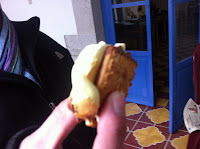Just like real scientific research, my analysis and report
on the experiments I did for the rocket stove took several weeks to finish
after performing the experiments. In
addition to the soot measurements, I also measured water boiling time and the
temperature distribution of the stove.
Como todas
investigaciónes de ciencia, mi anailis y reporte de los experimentos de las
estufas terminan algunas semanas despues de terminando los experimentos. Ademas de examiné la hollín, medí el tiempo
necessario hervir agua y la distribución de la temperatura en la estufa.
The water took the longest boil when the stove was started
from a cold start. When the water
boiling test was repeated when the stove was lit when it was already hot, the
same amount of water too half the time to boil. Decreasing the time to boil to half again was
possible by putting the pot inside the stove (see photo).
This is why many wood-burning stoves have pot skirts.
Agua
necesitó mas tiempe hervir cuando la estufa encendió de una frio tiempo. Menos tiempo necesitó cuando la estufa
encendió cuando ya estaba caliente (un medio de la otra tiempo encendió de la
frio estufa). Es posible reducir el
tiempo necisario hervir a medio otra ves si pone el olla adentro la
estufa (mira la foto). Esto es la razon que muchas
estufas de leñs tienen faldas de ollas.
The different temperatures of the surface of the stove were
studied with an infrared temperature sensor, and also with a much more real
world test of tortilla making. When
putting enough wood in the stove to get the rear burners to sufficient cooking
temperature, the front burner will burn the tortillas very quickly. But the rear burners of the stove are not hot
enough for cooking tortillas when the front burner was set to the ideal heat
for not burning the tortillas (by using less wood). I did find a great way to make use of the
rear burners when the front burner was at low heat; when open, the rear burners
were perfect for roasting
marshmallows and making s’mores.
Estudié la
distribución de la temperatura en la plancha usando una herrmienta de
temperatura como infraroja, y tambien hice un otra experimento mas real para
hiciendo tortillas. Cuando puse
suficiente leña en la estufa para hacer la plancha altras suficiente caliente,
la fronte de la plancha es demaciado caliente y las quemaré las tortillas muy
rapido. Pero cuando la fronte de la
plancha puede cocinar tortillas bien como menos leña, la plancha altras falta
suficiente calor y no puede cocinar. Yo
encontré una bien opción por la plancha altras cuando la fronte de la plancha
puede cocinar tortillas bien; la plancha altras esta perfecto para hacer
angelitos asado (o malvaviscos tostados) y u’p’mas**.
** s’mores
= some more = un poco mas = u’p’mas
This stove study was on the stove designed by Alterna. The other stoves I worked on with my Spanish
school in Guatemala
are discussed in their blog, including a post on our talk about soot!
In Peru, I haven’t seen many
cookstoves. In communities near the ocean where ceviche is common, cooking isn't necessary for this dish. Gas is also very cheap in Peru, so many families use gas stoves. I did see some three-stone fire pits for making chicha morada in one of the electricity-free houses. And we did build a campfire at a lagoon in the desert that would
have been perfect for making s’mores and roasting fish.


















.jpeg)